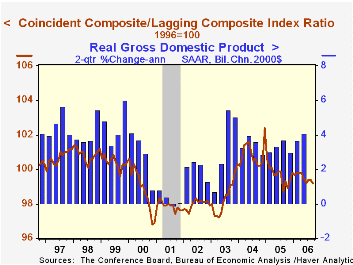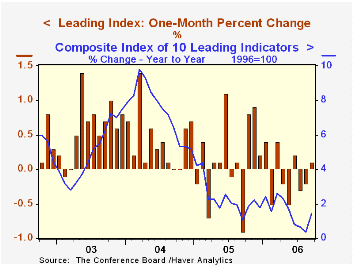 Global| Oct 19 2006
Global| Oct 19 2006Leading Economic Indicators 0.1% Rise Disappointing
by:Tom Moeller
|in:Economy in Brief
Summary
The Conference Board reported that the composite index of leading economic indicators ticked 0.1% higher last month following an unrevised 0.2% August decline. It was the first m/m rise since June but fell short of Consensus [...]

The Conference Board reported that the composite index of leading economic indicators ticked 0.1% higher last month following an unrevised 0.2% August decline. It was the first m/m rise since June but fell short of Consensus expectations for a 0.3% gain.
During the last ten years there has been a 59% correlation between the y/y change in the leading indicators and the lagged change in real GDP.
The breadth of one month gain amongst the 10 components of the leading index improved to 50%, the highest level since June.
The method of calculating the contribution to the leading index from the spread between 10 year Treasury securities and the Fed funds rate has been revised. A negative contribution will now occur only when the spread inverts rather than when declining as in the past. More details can be found here.
The leading index is based on eight previously reported economic data series. Two series, orders for consumer goods and orders for capital goods, are estimated.
The coincident indicators were unchanged following an upwardly revised 0.2% increase during August. Over the last ten years there has been a 91% correlation between the y/y change in the coincident indicators and real GDP growth.
The lagging indicators increased 0.2% for the second month as the CPI for services posted its largest positive contribution since late last year. The ratio of coincident to lagging indicators, which is a measure of actual economic performance versus excess, fell.
Visit the Conference Board's site for coverage of leading indicator series from around the world.
Inflation Persistence in an Era of Well-Anchored Inflation Expectations from the Federal Reserve Bank of San Francisco is available here.
| Business Cycle Indicators | September | August | Y/Y | 2005 | 2004 | 2003 |
|---|---|---|---|---|---|---|
| Leading | 0.1% | -0.2% | 1.4% | 2.3% | 7.4% | 5.0% |
| Coincident | 0.0% | 0.2% | 2.7% | 2.2% | 2.5% | 0.4% |
| Lagging | 0.2% | 0.2% | 2.8% | 3.5% | 0.0% | -0.0% |
Tom Moeller
AuthorMore in Author Profile »Prior to joining Haver Analytics in 2000, Mr. Moeller worked as the Economist at Chancellor Capital Management from 1985 to 1999. There, he developed comprehensive economic forecasts and interpreted economic data for equity and fixed income portfolio managers. Also at Chancellor, Mr. Moeller worked as an equity analyst and was responsible for researching and rating companies in the economically sensitive automobile and housing industries for investment in Chancellor’s equity portfolio. Prior to joining Chancellor, Mr. Moeller was an Economist at Citibank from 1979 to 1984. He also analyzed pricing behavior in the metals industry for the Council on Wage and Price Stability in Washington, D.C. In 1999, Mr. Moeller received the award for most accurate forecast from the Forecasters' Club of New York. From 1990 to 1992 he was President of the New York Association for Business Economists. Mr. Moeller earned an M.B.A. in Finance from Fordham University, where he graduated in 1987. He holds a Bachelor of Arts in Economics from George Washington University.






